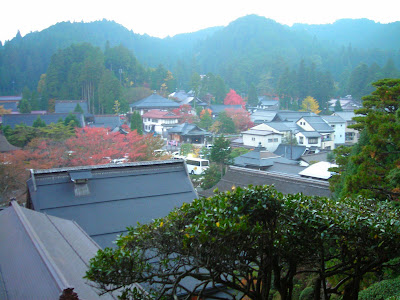My New Life (part 2)
So, you may be wondering, what is Numata like outside of my apartment? Well, it's not all doom and gloom.
This is a typical Japanese street. I walk down it every day, on my way to work. Note all the powerlines... this is very typical indeed.
Powerlines are a constant in Japan. The Japanese government seems to never have figured out that you could put them underground. They are everywhere. They block every view of the sky and the distant scenery. Whenever you look up, you see powerlines. It is almost inevitable. Still, you get used to it. Sometimes, it's almost beautiful...
We've had some spectacular sunsets so far.
This is another thing I see everyday on the way to work: a shrine.
Above you can see the entrance to the shrine, and also the graveyard, in the foreground. It's quite pretty, and has a beautiful view of the valley. It's a small shrine, but it's nice to have that quiet place in the neighborhood. I was afraid to go there for a while, because it also seems to double as someone's house. This is all part of the differing distinctions between private and public, and it makes things very confusing sometimes.
This is a picture of the cemetary, at sunset.
Like I said, it's not all doom and gloom. Here are some of the beautiful flowers that I passed every day on the way to school. (Unfortunately, all gone now.) These kinds of flowers also came in white and purple. There were also these enormous tropical looking things, big as a saucer. I didn't get a picture of one, unfortunately, but they were really beautiful.
This is something cool I pass on the way to school as well. It's a fresh vegetable vending machine. There is a small farm behind this vending machine, which seems to be run by some extremely elderly Japanese people. There are a number of compartments like this, each with a different bag of vegetables. They all sell for 100 yen, and are generally quite a bit cheaper than the grocery store. They sell all kinds of things--tomatoes (usually very pricy, but the tomato season seems to be over now!), eggplants, carrots, potatoes, cucumbers, and now they've started to sell broccoli as well. It's really cool! I buy things quite often. The eggplants were really good in some stirfry.
Here you can see my school itself--Numata Girls Senior High School. We call it Numajo for short, because it Japanese it is called Numata Joshi Koukou. As you can see, it's a yellow building. You can't really see in this picture, but it's quite large. Definitely bigger than Cascade was. It's got 4 floors, and all together there are four buildings, set around a central plaza area. (All the buildings are connected, but they are technically different buildings.) In the center, there's a nicely sculpted garden and a teahouse for the tea ceremony club. This picture is more flattering than the building actually is. It is not beautiful. Like most public buildings, as I mentioned earlier, it is made of concrete and firmly set in the "Brutalist" style. Still, it's better than the boys' high school, which practically dates back to the war and is absolutely filthy. (Basic upkeep of buildings is not high on most Japanese peoples' lists.)
These are some other interesting photos of Numata...
This is the train station. It's quite small compared to most train stations I saw before (e.g. in Tokyo), but it works well enough. Trains don't come very often though--about once an hour. That's more than a little annoying, but oh well. There are two platforms, and trains only go 2 ways: north and south.
Actually, the train in this photo is a special train. It was heading up north, towards Minakami, and it seemed to be some kind of sight-seeing train. Basically, it was steam-powered. There was a huge pile of coal in the back and all this smoke coming out the top. When it got to the station it let out a horrible screeching whistle (Japanese trains normally never do this.) When it pulled into the station, a bunch of random people got off and started filming and taking pictures of the train! Then the announcement came that it was leaving, and everyone jumped back on til the next stop. Extremely strange, really.
This is a picture of the mountains, for once unsullied by powerlines or ugly concrete buildings. As you can see, it is really beautiful. Sometimes it's easy to forget that, but whenever I ride the train, I can see some really beautiful scenery--jagged cliffs that look like some kind of postcard, like nothing I've ever seen in Oregon; wide rice paddies; rivers deep in rough valleys. It's pretty spectacular, really.
This is what lies below those mountains you can see above.
It's beautiful in its own way, I think. Still, there are a lot of people here and this demonstrates that. I wonder why the roofs are so many different colors. I guess its the same reason my apartment building is painted pink...

